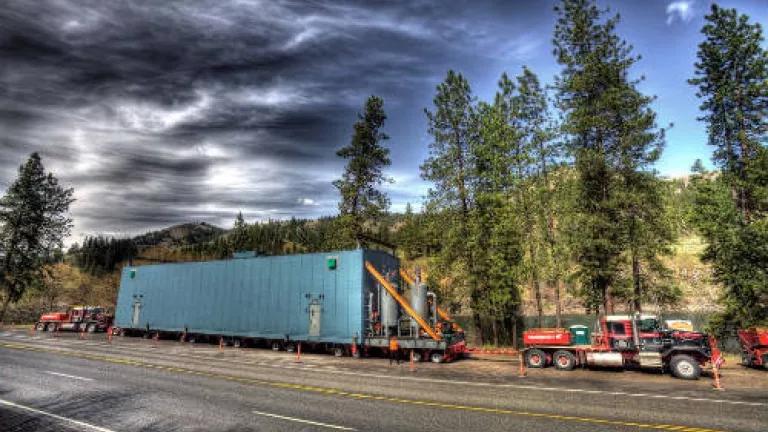
The original test module parked adjacent to the Clearwater River in Idaho. This shipment, which has been parked at Lolo Hot Springs in Montana since May 2011, will be demolished and cut into a series of smaller pieces. Photo credit: Dave King
The controversial and unwelcomed proposal to ship oversized Exxon “Megaload” shipments through the wild and scenic regions of Idaho and Montana is officially dead. Imperial Oil, the Canadian subsidiary of Exxon, formally withdrew its application with the state of Montana to seek permission to ship +200 Megaloads through the Rocky Mountains, onwards to Canada to serve the mining of tar sands in Alberta. A gigantic test shipment — that has been parked at Lolo Hot Springs in Montana ever since the shipment was halted halfway on its journey in May of 2011 due to a series of fiascos on its maiden voyage — will be demolished and removed piece by piece (this first test shipment took out some trees and knocked out electrical power to a small town in Idaho). In an act of poetic karma, it’s hard to imagine a more befitting end to such a harebrained scheme that threatened one of the most pristine areas in the United States. In addition, not enough can be said about the regional groups and citizens in Idaho and Montana who really went out on a limb to fight the impossible fight, such as Fighting Goliath and All Against the Haul.
When NRDC was first alerted two years ago by its regional partners about Exxon’s Megaloads scheme, the world’s largest oil company was well on its way in secretly working with Idaho authorities to turn the region’s rural backcountry highways into a new industrial shipping corridor. Exxon had already initiated the process to widen the narrow two-lane byways in Idaho that would host these shipments – pathways that had changed little from when the Lewis and Clark Expedition travelled on the same mountain passes two hundred years before.
In essence, Exxon had assumed this was going to be a cake walk – but they completely underestimated what this special region meant to the locals and beyond. Thankfully, these regional voices, along with NRDC members and activists raised enough of a furor to force the state of Montana to take a second look at what Exxon was proposing on the Montana side (and later in the summer of 2011, a lawsuit brought by Montana activists and organizations secured a restraining order precluding further shipments temporarily). During this time, NRDC was also able to unearth evidence that the Megaload shipping plan was not likely the one-off deal Exxon was claiming it was – for we were able to translate documents and press clippings from South Korea where the shipments were being assembled, that established that Exxon was in the process of contracting for thousands of shipments more than Exxon had publicly admitted to.
These delays and the court enforced restraining order certainly had an impact on Exxon’s plans. We know now that Exxon had to initiate a series of complicated modifications to their original development plan that did not rely on the once certain notion of shipping Megaloads through the Rockies. But maybe more importantly, as we have seen with the fight over the Keystone XL pipeline, when citizens raise their voice in resistance to truly bad ideas that endanger our nation’s most beloved landscapes, as typified by the Megaload scheme, Goliath sometimes doesn’t stand a snowball’s chance in the face of such concerted opposition.
In addition, not enough can be said about the regional groups and citizens who really went out on a limb to fight the impossible fight, such as Fighting Goliath and All Against the Haul.



